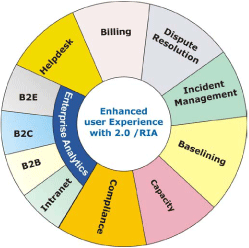|
|
|
| |
leads to the reduction of the database round
trips.
Web 2.0 applications also manages complex
relational models for its data. Social networking
sites mainly manages and represents the
relationships among the users. Today, Seam is
the sole technology that supports lazy loading
for web application in the right direction.

4. A Web Framework that Understands
ORM
Today’s most of the applications use the
Object Relational Mapping (ORM) solutions.
However most of these applications use those
business and web frameworks which are not
designed for ORM. Such framework does not
even handle the persistence context throughout
the interaction lifecycle starting with a request
to render a response.
Initially Seam was designed to promote as a
ORM best practices. In case of Seam, no more
DAOs are required to write; only lazy loading
can work. Since the extended persistence
context behaves like a natural cache and reduces
database round trips therefore the ORM
performance greatly improves. Since Seam |
|
integrates the ORM layer with the business and
presentation layer, therefore ORM objects can
be observed working directly.
5. POJO Services via Dependency
Bijection
Seam is a “lightweight framework” as it uses
POJO (Plain Old Java Objects) as its services
components. No framework dependent
interfaces or abstract classes exist in Seam
which does not allow the components to get
hooked into the applications. This generates a
curiosity to know the things like how do the
POJOs interact with each other to develop an
application and How do they interact with the
services of the container.
Seam uses the most commonly used designed
pattern known as “dependency injection” (DI)
to connect to the POJO components with each
other. Seam maintains the life cycle of all of its
component with the implementation of the DI
design pattern. Whenever a component uses
another component then it shows this
dependency to Seam with the help of
annotations. Seam decides the injection place
of this component according to the application’s
current state.
Let’s take a seam component say P which needs
to create another component say Q. It does
that simply by expanding the dependency and
“outjects” the component Q back to Seam for
another components say R to later use it. This
type of bi-directional dependency management
is known as dependency bijection.
6. Avoid XML Abuse
Java annotations play an important role to
express and manage the Seam configuration
metadata. In the beginning of J2EE, XML was
supposed as the better option for configuration
management. Framework designers put all the
configuration related information (such as Java
classes and method names) into the XML files.
However, it was not an optimised solution
because XML configuration files are repetitive
in nature i.e. already existing information in the
code is repeated just to connect the
configuration with the code and this makes |
|
Oct 2007 | Java Jazz Up |28 |
| |
|
| |
Pages:
1,
2,
3,
4,
5,
6,
7,
8,
9,
10,
11,
12,
13,
14,
15,
16,
17,
18,
19,
20,
21,
22,
23,
24,
25,
26,
27,
28,
29,
30,
31,
32,
33,
34,
35,
36,
37,
38,
39,
40,
41,
42,
43,
44,
45,
46,
47,
48,
49,
50,
51,
52,
53 ,
54,
55,
56,
57,
58,
59,
60,
61,
62,
63 ,
64,
65 ,
66 ,
67 ,
68 ,
69 ,
70,
71,
72,
73,
74,
75,
76,
77,
78,
Download PDF |
|
|
|
|
|
|
| |
| |
|